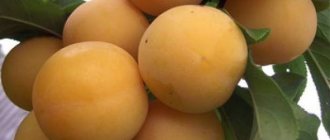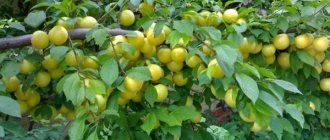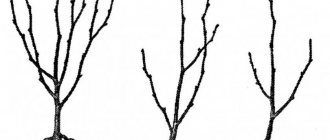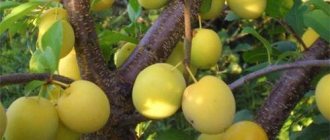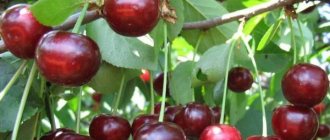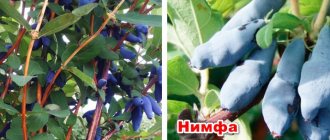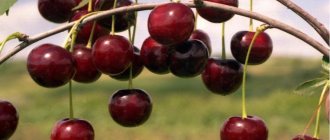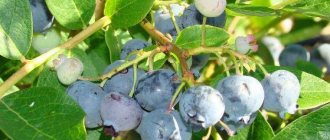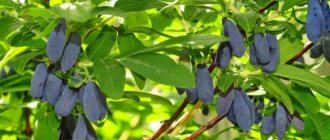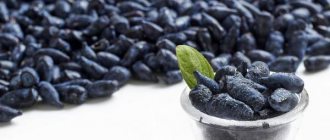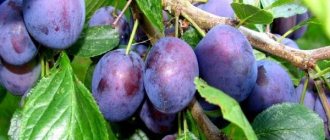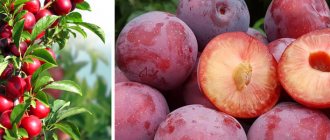Description and distinctive features of the variety
The cherry plum variety Traveler is a hybrid of Russian plum.
In appearance, the tree is not tall and reaches three meters in height; its crown is compact and not very dense. The leaves of the cherry plum are pale green in color with a pointed end. The flowers that appear are white and large in size. Distinctive features:
- The fruits on the tree have an average weight of 20-30 grams. Their skin is smooth and purple-red.
- Separating the pit from the pulp is quite difficult.
- The traveler's cherry plum variety is unpretentious in care and has no special preferences.
Gardeners give the following characteristics of the fruit:
- In cross section, cherry plum has an orange color and a fine fibrous structure.
- medium-temperary
- some time after cutting the fruit, it begins to darken.
- tastes a little sour.
- The aroma is pleasant, delicate, and spreads over a short distance.
- small bone.
Description
The cherry plum variety is a hybrid species of Russian plum. The trees grow quickly, up to 3 meters high. The crown is moderately dense, shaped like a wide oval. The trunk has smooth, gray bark. The branches are straight, thick, have long spears that live for a short time.
- The inflorescences are large in size, formed in pairs. Flowering occurs in mid-April.
- The fruit grows weighing 28 grams, round in shape, with a noticeable seam on the side. The skin is of moderate density, difficult to separate from the orange pulp with thin fibers.
- Cherry plum of the Traveler variety is found in a yellow-violet hue, with many dots.
- The sugar content is low, 7.6%, moderate acidity – 2.5%.
- The variety received a tasting score of 4.2 points, 100 grams contain 34 kcal.
- The plant does not pollinate on its own.
The variety is suitable for cultivation for personal consumption or sale.
Pros and cons of the variety
Before planting a tree, you should consider all its advantages and disadvantages. Among the advantages of the variety are:
- Good tolerance to harsh winters.
- Rapid appearance of fruits.
- Annual harvest.
- It is not susceptible to diseases such as moniliosis and klyasterosporiosis.
Flaws:
- The variety does not tolerate dry weather well.
- From the photo description of the cherry plum variety Traveler, it can be seen that the ripened fruits are small in size.
- The pulp is difficult to separate from the bone.
- Since the flowers begin to bloom very early, there is a danger of them freezing during spring frosts.
- Cherry plum fruits are not stored for a long time.
Diseases and pests
Fungal diseases damage the bark, leaves, and shoots of the Naiden cherry plum variety. In addition to diseases, garden crops are attacked by pests.
Aphid
Plum aphids are one of the pests that cover the lower leaves of plum trees. To treat areas, use solutions: “Karbofos” or “Sumition”.
Sawfly
A worm that feeds on inflorescences and fruits is called a sawfly. The pest is controlled using the drugs “Cyanox”, “Rogor” and solutions “Karbofos” or “Chlorophos”. Spraying is carried out before flowering.
Rodents
Rodents feed on the roots and trunks of the Naiden cherry plum, most often in late autumn and winter. To protect the fruit tree, its lower part is covered with straw, paper, spruce branches or scraps of fabric soaked in creolin.
Polystigmosis
Polystigmosis affects cherry plum leaves, causing burn spots to appear on them. For treatment or prevention, fungicidal preparations are used; spraying is recommended from the highest shoots to the lowest.
Centipede
An insect resembling a fly damages the seed of the Naidena plum variety. A massive attack of the thick stalk occurs a week after flowering. During this period, you need to spray all parts of the plum with insecticides.
codling moth
Insecticides also help against the codling moth, which eats leaves and fruits. This insect is first a larva, then a caterpillar, and then a butterfly.
Features of planting and caring for cherry plum
This variety of cherry plum is suitable for any type of soil, begins to bear fruit early and pleases gardeners with an annual harvest. However, there are some features in planting and caring for the Traveler cherry plum that need to be taken into account:
- For planting, it is best to choose lighted places where there is no strong wind.
- Groundwater in the planting soil must lie at least 1 meter from the surface.
- A good option would be slightly alkaline, loamy soils.
- It is best to plant cherry plum in the spring.
If you plant seedlings in the fall, they may not have time to take root and will not survive frost and cold.
Landing technology
Deciding on deadlines
As a rule, under conditions of a closed root system, seedlings are planted from April to October. If the root system is open, the plant is planted with the arrival of spring.
Optimal landing place
You should not plant cherry plum on flooded and swampy soils; excessive moisture is detrimental to the tree. Also, the soil should not be heavy. Choose a sunny area, protected from the winds. Such protection can be a slope, a fence, or other trees.
Recommended and contraindicated neighborhoods
A good neighborhood will be ensured by planting cherry plum trees nearby. The tree also gets along well with gooseberries, blackcurrants and other shrubs.
You should not plant fruit trees next to plum trees. However, the apple tree may be an exception.
Seedling preparation
When choosing a seedling, carefully examine it. The plant must have a good root system
Also pay attention to the crown and trunk of the tree. The foliage should be healthy and the trunk should not have cracks
You should purchase seedlings in the fall, at which time you will have much more choice. For the winter, seedlings should be stored in a cool place, where the temperature will be from 0 to +5 degrees.
Planting scheme
Before planting, the seedling should be inspected again. If the root system is open, it should not have less than 5 shoots. Also check it for root damage. Old roots must be removed.
The hole is dug in advance. The recommended depth is about 70-80 centimeters. The diameter may be approximately the same. Depending on the composition and quality of the soil on your site, you can add to the hole:
- sand;
- peat;
- turf;
- lime.
Fertilizers such as potassium and superphosphate will also not be superfluous.
When starting to plant, you need to form a mound in the center of the hole and place a peg on it. Attach the seedling tightly to the stake, carefully spreading the roots around. After which the seedling is covered with earth, the soil next to the plant is compacted.
Pollinator varieties
Cherry plum Traveler can be called a self-fertile variety. However, to obtain a rich harvest, you will need other varieties planted nearby. The best pollinator for the Traveler plum will be the Russian or Chinese plum variety, as well as the Skoroplodnaya plum.
The Traveler cherry plum itself can become an excellent pollinator for other cherry plum varieties.
Preparatory work before planting a tree
2 weeks before planting, it is necessary to prepare the soil well. It must be dug deeply and freed from plant roots. You can increase soil fertility by applying fertilizer consisting of the following elements:
- Humus – 15 kg,
- Superphosphate – 50 g,
- Potassium salt – 60 g.
Garden soil is added to this mixture, everything is mixed (in a hole is possible), and the holes are filled 2/3. Acidic soil is limed by adding wood ash in an amount of 400-500 g per square meter. Holes should be dug based on the following indicators:
- depth - 50-60 cm,
- hole diameter from 0.7 to 1 meter,
- the distance between the holes is 2-2.5 meters.
Place drainage at the bottom of the hole to prevent moisture from stagnating.
How to care
Despite the fact that this variety of cherry plum produces an annual harvest, it is worth caring for the tree. This is the only way to preserve it much longer and get an increasingly rich harvest. The plant requires regular watering, fertilizing and pest control.
How to trim cherry plum
This is a very important stage of plant care. Thanks to pruning, the tree is protected from various diseases, grows and forms better, and the yield increases. During the first year after planting the plant, it must be cut by 1/3. Afterwards, such manipulations are carried out to improve the appearance and to ensure sunlight reaches the entire plant.
During autumn and spring, it is necessary to cut off all diseased, dry and crooked branches.
Plant nutrition
If organic fertilizers were poured into the hole for the seedling, then in the next two years the tree does not need feeding. Humus, compost, manure, and saltpeter are used as fertilizers.
How to ensure proper watering
This variety of cherry plum does not like very wet soil with stagnant water. Therefore, you need to water frequently, but in small quantities. As the tree grows, the volume of water increases from 2 to 6 buckets. During the rainy season, the amount of water should be reduced.
In winter, the plant does not require watering, but on the contrary, in order to avoid stagnation of water, it is necessary to dig special drainage grooves into which all unnecessary water will go.
Description and photo of the cherry plum variety Traveler indicates its unpretentious nature, rich harvest and the ability to plant seedlings in any soil. With proper care and provision of seedlings with all useful elements, you can provide yourself with a harvest for many years.
Diseases and pests
Cherry plum Traveler is resistant to viral diseases, as well as clasterosporiasis and moniliosis. However, to increase the resistance of fruit trees to pests and diseases, preventive measures should be carried out in a timely manner.
Prevention and methods of combating cherry plum diseases - table
| Disease | Description and nature of the lesion | Processing period | Prevention measures | Fighting methods |
| Powdery mildew | It forms in the form of an actively spreading gray-white coating. It affects the shoots, trunk, branches and leaves of the tree. | April | Timely sanitary pruning with removal and subsequent burning of affected areas of the tree. Treatment of sections with a solution of 1% copper sulfate. | Spraying the tree with colloidal sulfur and copper sulfate (20 g/10 g/10 l of water). |
| Clusterosporiasis | A fungal infection that spreads from diseased trees to healthy ones along the wind. The radius of propagation is calculated in kilometers, so it can fly from distant neighboring areas. It affects leaves and young branches mainly in damp and rainy weather. Leads to premature leaf fall. |
|
| Spraying the tree with a 1% solution of Bordeaux mixture to prevent infection. |
| Moniliosis | Damages the trunk, branches and leaves of the tree. Appears as white-gray spots. | Before the buds open. | Regular sanitary pruning of disease-affected areas of the tree, covering the healthy area by 7–10 cm. | Spraying the tree with Nitrafen (300 g per 10 l of water) or copper sulfate (100 g per 10 l of water). |
| Rust | It affects leaves, causing them to curl and fall prematurely. Reduces the frost resistance of the tree. | If the disease is detected, every 18–20 days. |
| Treating trees with a solution of 1% Bordeaux mixture (100 g per 10 liters of water). |
Possible tree diseases in the photo
When rust develops strongly, the leaves fall off, which leads to a weakening of the tree and a decrease in its winter hardiness.
Powdery mildew is especially severe when precipitation is followed by dry, hot weather.
Moniliosis spreads especially strongly in years with prolonged flowering and high air humidity.
Trees affected by clasterosporiasis stop bearing fruit, as their buds die and the flowers completely fall off
Prevention and methods of controlling cherry plum pests - table
| Pest | Nature of the lesion | Processing period | Prevention measures | Fighting methods |
| Aphid | Small insects settle on the undersides of leaves, as well as on the tops of trees. They feed on the sap of young leaves, causing them to curl, dry out and fall prematurely. | When insects are detected until they are completely destroyed. |
| Spraying the tree with tinctures of tobacco dust, onion peels, and garlic every 4–5 days. |
| Plum moth | The pest's caterpillars damage the pulp and kernels of fruits, feeding on them. Affected fruits spoil and fall off. | When caterpillars appear - twice with an interval of 14 days. |
| Spraying the tree with Chlorophos or Karbofos according to the instructions. |
| Brown fruit mite | Small insects of red-brown color. They feed on the juice of young leaves, entangling them in a web, which leads to curling and subsequent drying out. They damage the fruits. | Before the buds open. |
| Treatment of wood with Karbofos, Phosfamide or colloidal sulfur every 15–20 days. |
Pests in the photo
Fruits damaged by plum moth caterpillars rot and fall, reducing the amount of harvest
Most often, brown fruit mites inhabit the middle or lower parts of tree crowns.
Leaves damaged by aphids curl and fall off
Features of culture
“The Traveler” is distinguished by its unpretentiousness:
- The tree is winter-hardy and tolerates cold well.
The buds do not withstand frost so confidently - if they bloom early, they may freeze, resulting in a decrease or absence of yield.
- The variety is resistant to many diseases that affect other stone fruits, in particular to clasterosporiosis, moniliosis and various viruses.
- The tree bears fruit consistently and its yield is high.
Productivity, collection and storage
The Traveler variety begins to bear fruit 3-4 years after planting. The fruits ripen in early July and harvesting lasts 4-5 weeks. Overripe fruits fall from the tree, so you need to collect them on time.
Fruiting of the Traveler variety is annual and regular; you can get 30-40 kilograms of fruit from one tree. They are unsuitable for long-term storage and transportation due to their loose and soft pulp. In the refrigerator, the collected cherry plum remains fresh for 3-4 days.
The purpose of the Traveler cherry plum fruits is universal: you can eat them fresh or use them to make jam, preserves, compote, and homemade infusions.
